Intercomparison of Data-Driven and Learning-Based Interpolations of Along-Track Nadir and Wide-Swath SWOT Altimetry Observations †
Abstract
1. Introduction
2. Case Study and Data
2.1. NATL60
2.2. Nadir
2.3. SWOT
2.4. DUACS OI Products
3. Methods
3.1. AnDA
3.2. VE-DINEOF
3.3. End-To-End NN-Learning
3.3.1. Architecture
- First, classic convolutional auto-encoder (ConvAE) representations where the encoding operator maps the anomaly state onto a lower-dimensional space and the decoder has to project this encoded representation in the original space. It involves the following encoder architecture: five consecutive blocks with a Conv2D layer, a ReLu layer and a 2 × 2 average pooling layer—the first one with 40 filters and the following four ones with two times the number of filters of the previous Conv2D layer (i.e., 80, 160 and 320 filters); and a final linear convolutional layer with 20 filters. The output of the encoder is 5 × 5 × 40. The decoder involves a Conv2DTranspose layer with ReLu activation for an initial 20 × 20 upsampling stage a Conv2DTranspose layer with ReLu activation for an additional 2 × 2 upsampling stage, a Conv2D layer with 40 filters and a last Conv2D layer with 22 filters (the length of the image time series times the number of covariates—the OI used in the model). All Conv2D layers use 3 × 3 kernels. Overall, this model involves ≈ 600,000 parameters.
- GE-NN: Second, NN-based Gibbs energy (GENN) representations where , the anomaly observed at location , is supposed to be explained by the potential function with a predefined neighborhood of site , thereby relating this representation to Markovian priors embedded in CNNs. A low energy-state over the entire domain ensures providing a good state space reconstruction. Regarding the architecture involved, the following scheme is used: an initial 4 × 4 average pooling; a Conv2D layer with 40 filters, 11 × 11 kernel, ReLu activation and a zero-weight constraint on the center of the convolution window; a 1 × 1 Conv2D layer with 40 filters; a ResNet composed of an initial mapping to an initial 200 × 200 × (5 × 40) space with a Conv2D+ReLu layer; and a linear 1 × 1 Conv2D+ReLu layer with 40 filters. Last, a final 4 × 4 Conv2DTranspose layer with a linear activation for an upsampling to the input shape is considered. GE-NN involves 10 residual units for a total of ≈450,000 parameters.
3.3.2. Fixed-Point Solver
4. Evaluation
4.1. Experimental/Benchmarking Setup
4.2. GULFSTREAM
4.3. OSMOSIS
5. Discussion
- A significant gain from data-driven methods compared to the OI-based DUACS baseline: up to 40% relative gain in the SSH daily root mean squared error, in particular on the GULFSTREAM domain where the small scale spatial patterns structures are less noticeable compared to OSMOSIS.
- A better reconstruction performance of the learning-based GENN introducing a GMRF representation closely related to Gibbs energy concepts compared to AnDA and DINEOF.
- A significant contribution from the 2D spatial information provided by the additional SWOT sampling to improve the reconstruction of altimetric fields with a relative gain up to 30% in the SSH daily mean squared error, when compared to the single use of along-track nadir 1D information. Within this combined use of the two datasets, the spectral analysis indicates the new capability to reconstruct spatial scales up to 50–60 km which is an important improvement compared to the scales that OI is handling by now; on the other hand, the temporal sampling being less important than nadir tracks, in particular on the GULFSTREAM domain where periods of several days without any SWOT information appears, the reconstruction on these specific periods is sometimes better when learning only with along-track nadir as inputs: we believe that a longer training period (not available here) should improve the behavior of the NN on this specific issue.
- The possibility for neural network methods to learn from the single observations, without requiring any numerical simulations, which is of particular interest on low latitude areas where the Rossby radius of deformation is large, thereby requesting an important catalog to efficiently retrieve the SSH dynamics over the year.
- Use a joint learning of the dynamical representation and the solver , minimizing its reconstruction error. A significant gain in the reconstruction performance is expected according to preliminary results obtained with toy models [16].
- A stochastic extension of GENN for including in the NN-based framework an estimation of the uncertainties, thereby enabling this new reconstruction method to fully compete with the other interpolators in a “data assimilation” context, with a possible link whith Gaussian processes and the related stochastic PDE formalism [18,19].
Supplementary Materials
Author Contributions
Funding
Conflicts of Interest
Appendix A. Complementary Figures for SSH Interpolations
Appendix A.1. GULFSTREAM
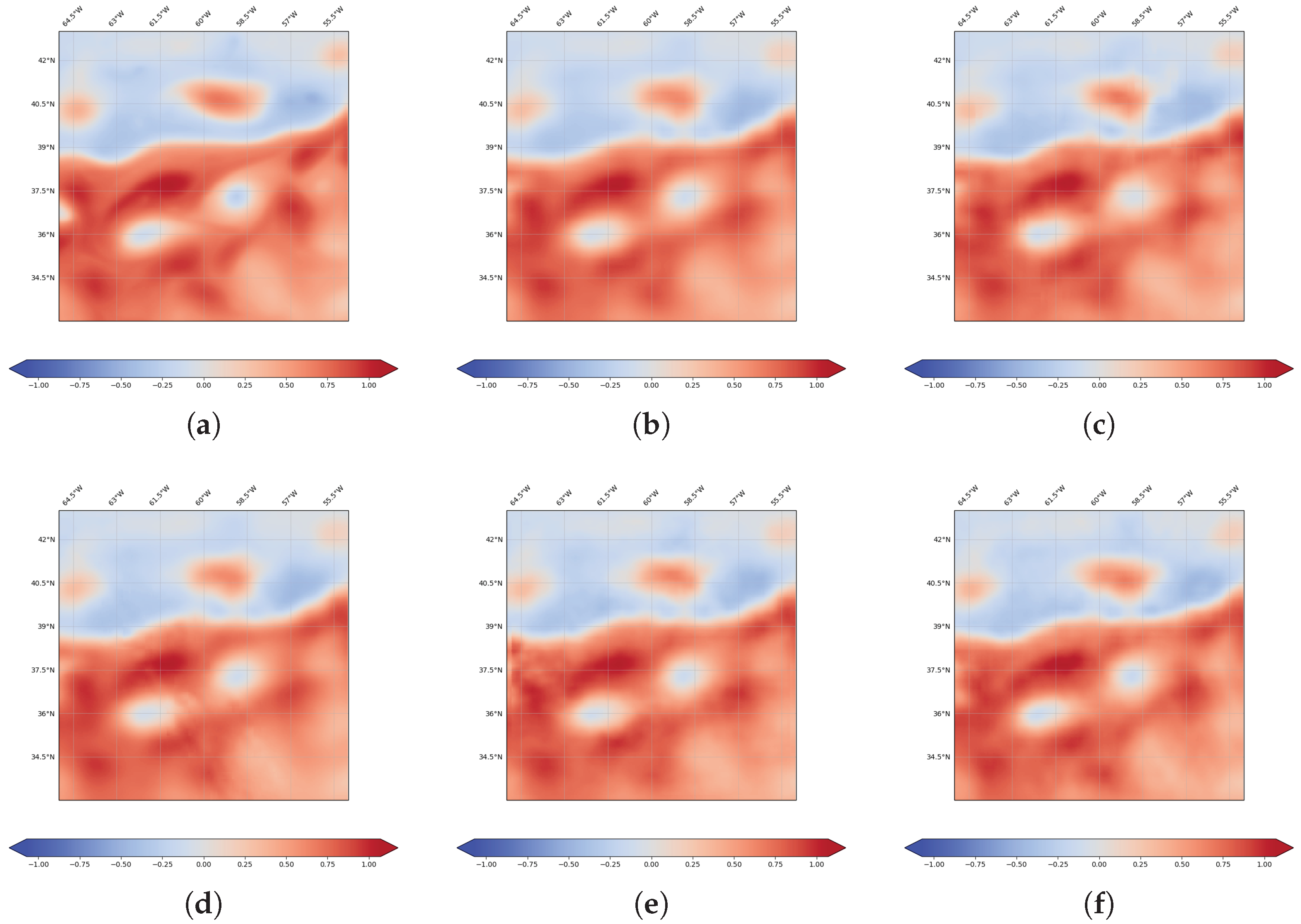
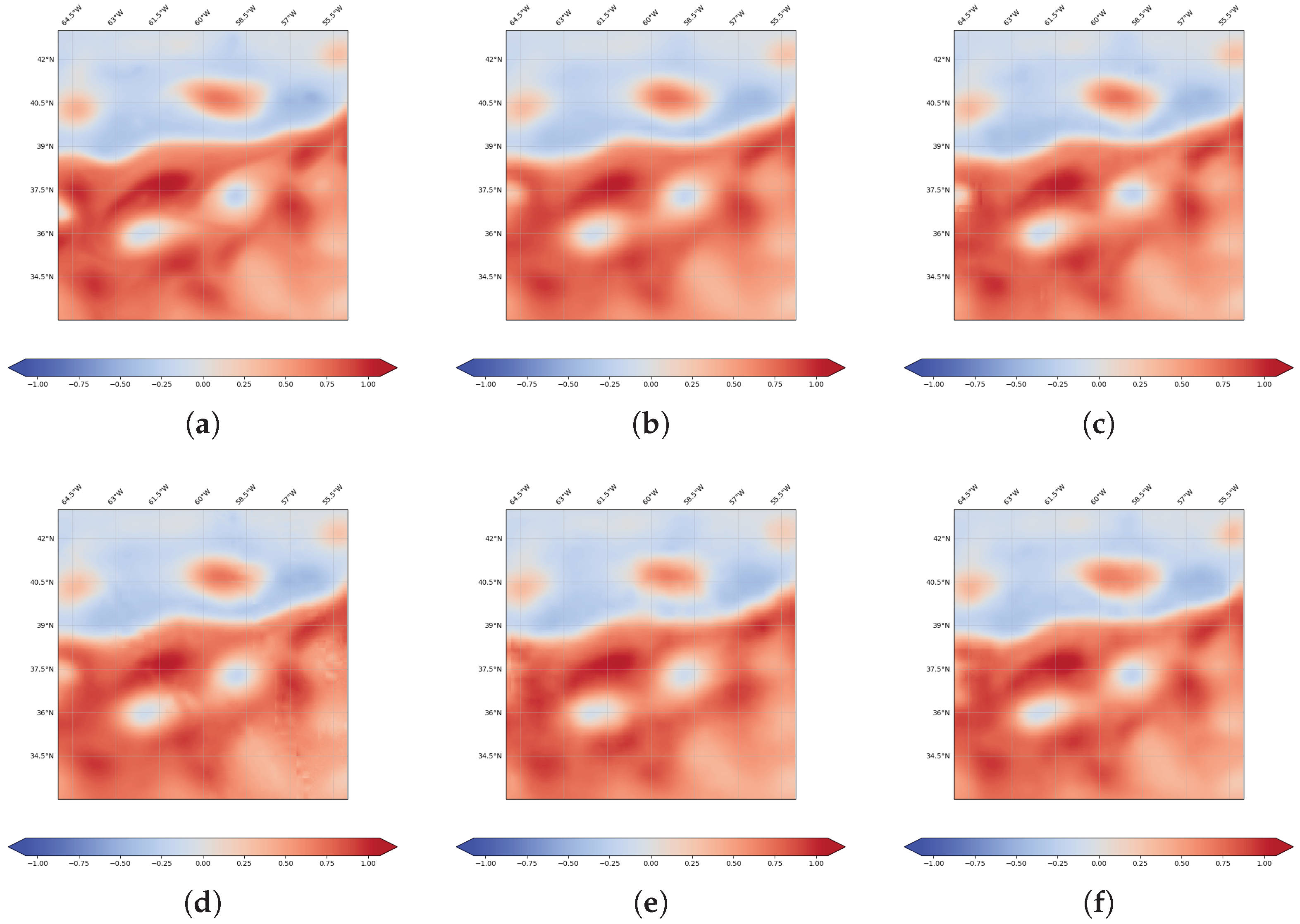
Appendix A.2. OSMOSIS
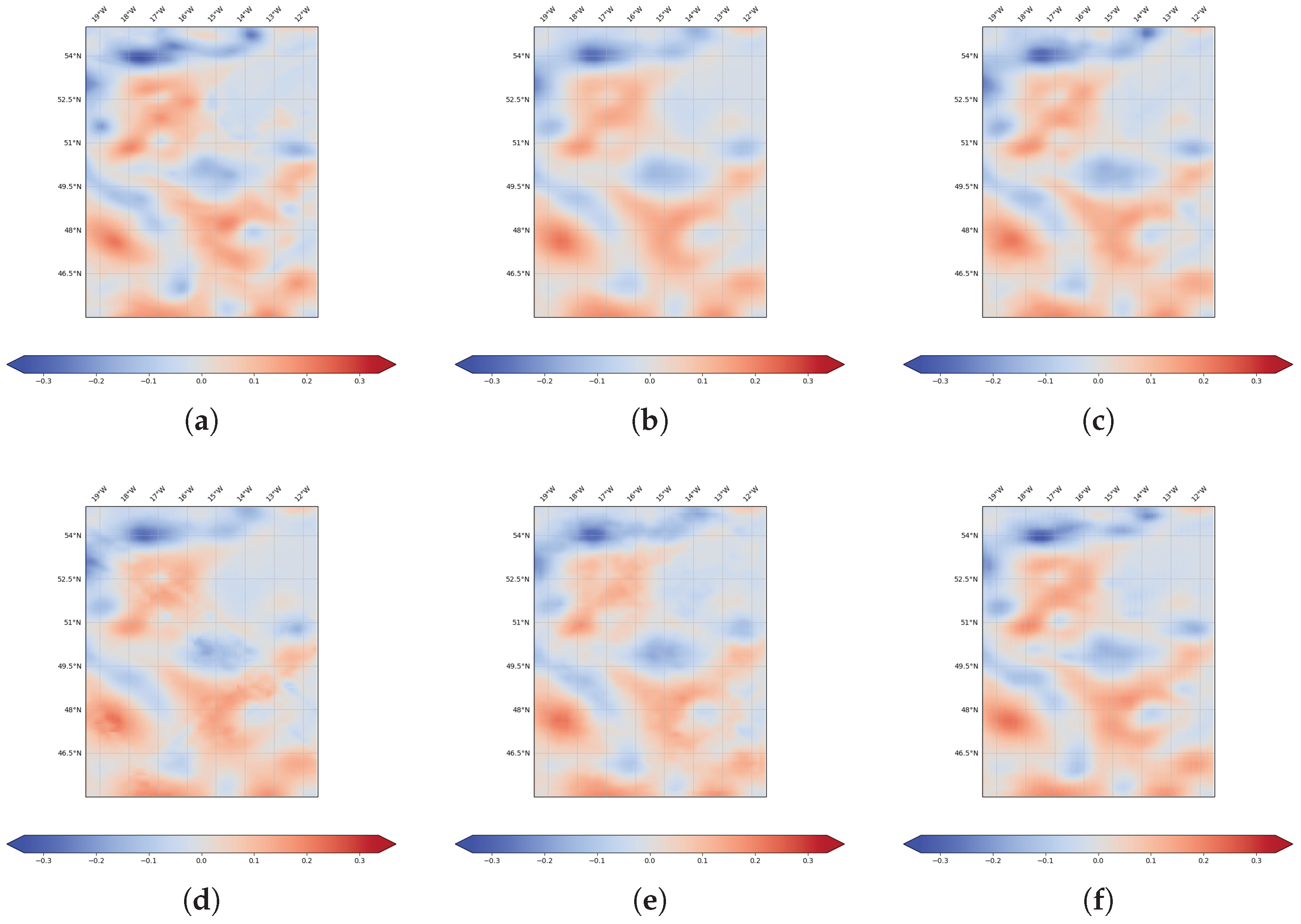

Appendix B. OSSE without Observation Errors
Appendix B.1. GULFSTREAM


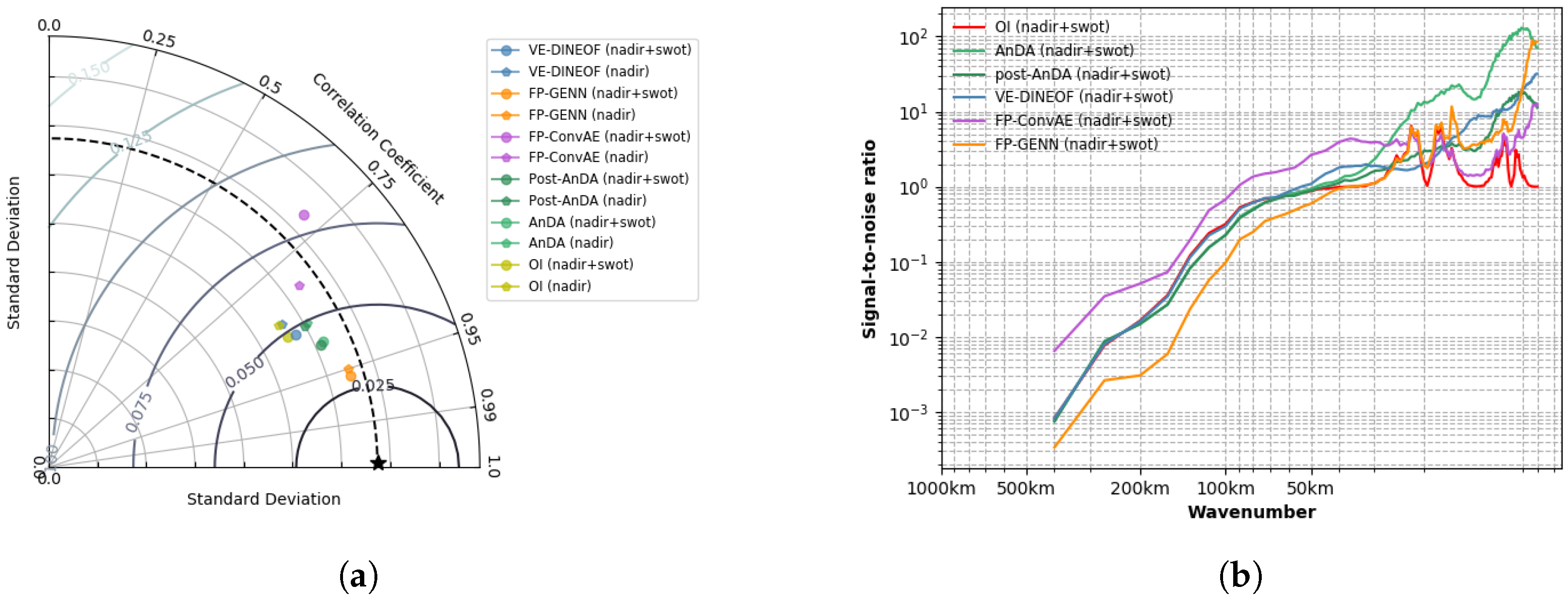
| Model Type | R-Score | I-Score | AE-Score | Model Type | R-Score | I-Score | AE-Score | ||
|---|---|---|---|---|---|---|---|---|---|
| nadir | OI | 86.53 | 72.25 | _ | nadir | 76.14 | 72.41 | _ | |
| AnDA | 90.56 | 76.81 | _ | 81.81 | 76.15 | _ | |||
| VE-DINEOF | 91.33 | 72.58 | _ | 80.09 | 72.07 | _ | |||
| FP-ConvAE | 69.46 | 63.82 | 79.86 | 58.30 | 59.79 | 70.14 | |||
| FP-GENN | 95.15 | 91.28 | 96.32 | 84.75 | 84.63 | 88.05 | |||
| nadir + SWOT | OI | 91.76 | 75.30 | _ | nadir + SWOT | 71.41 | 72.31 | _ | |
| AnDA | 91.72 | 82.43 | _ | 85.85 | 79.80 | _ | |||
| VE-DINEOF | 92.47 | 76.00 | _ | 84.73 | 73.36 | _ | |||
| FP-ConvAE | 42.78 | 34.96 | 79.93 | 31.78 | 36.48 | 69.72 | |||
| FP-GENN | 97.31 | 91.45 | 96.87 | 87.75 | 85.35 | 89.50 |
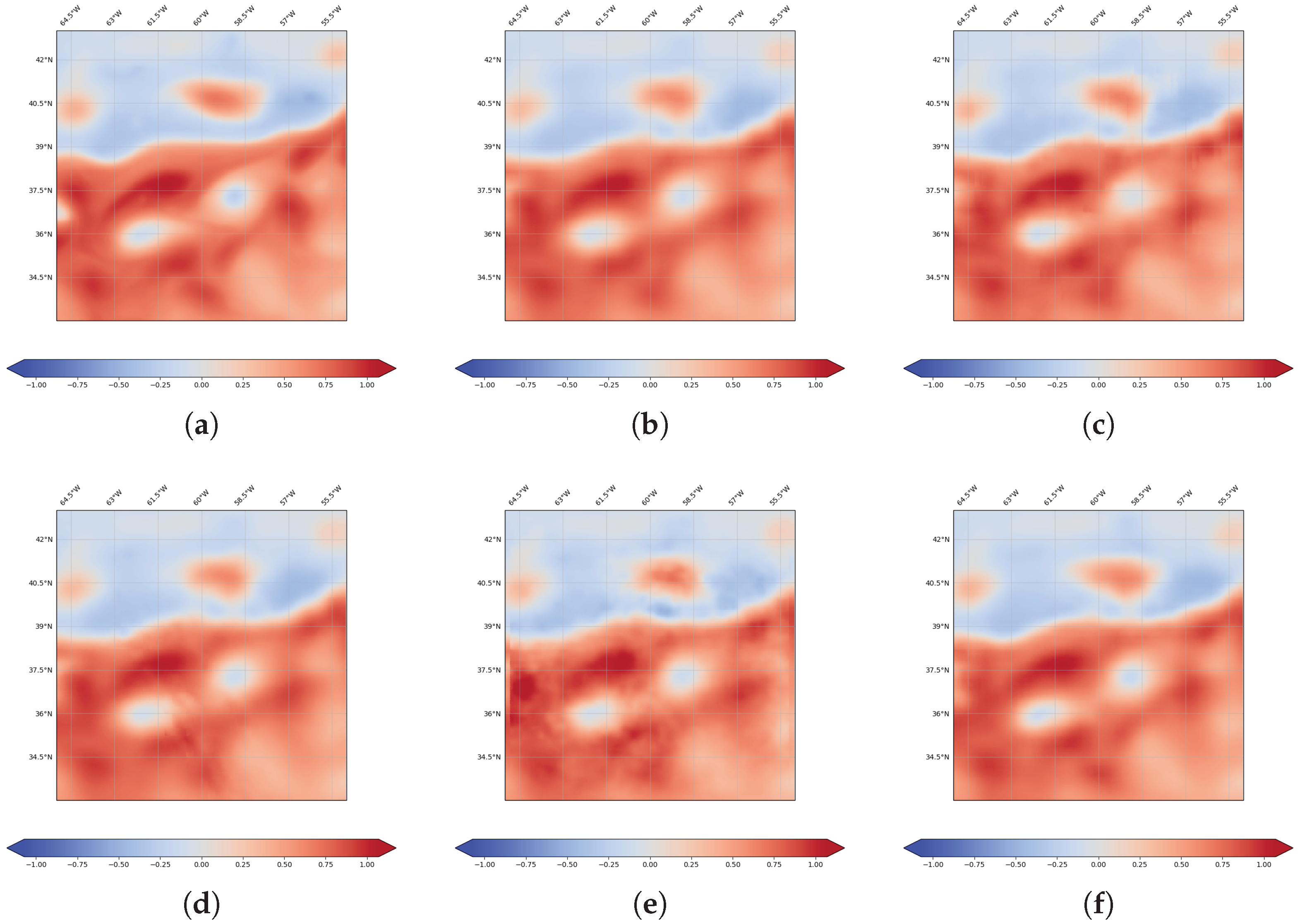
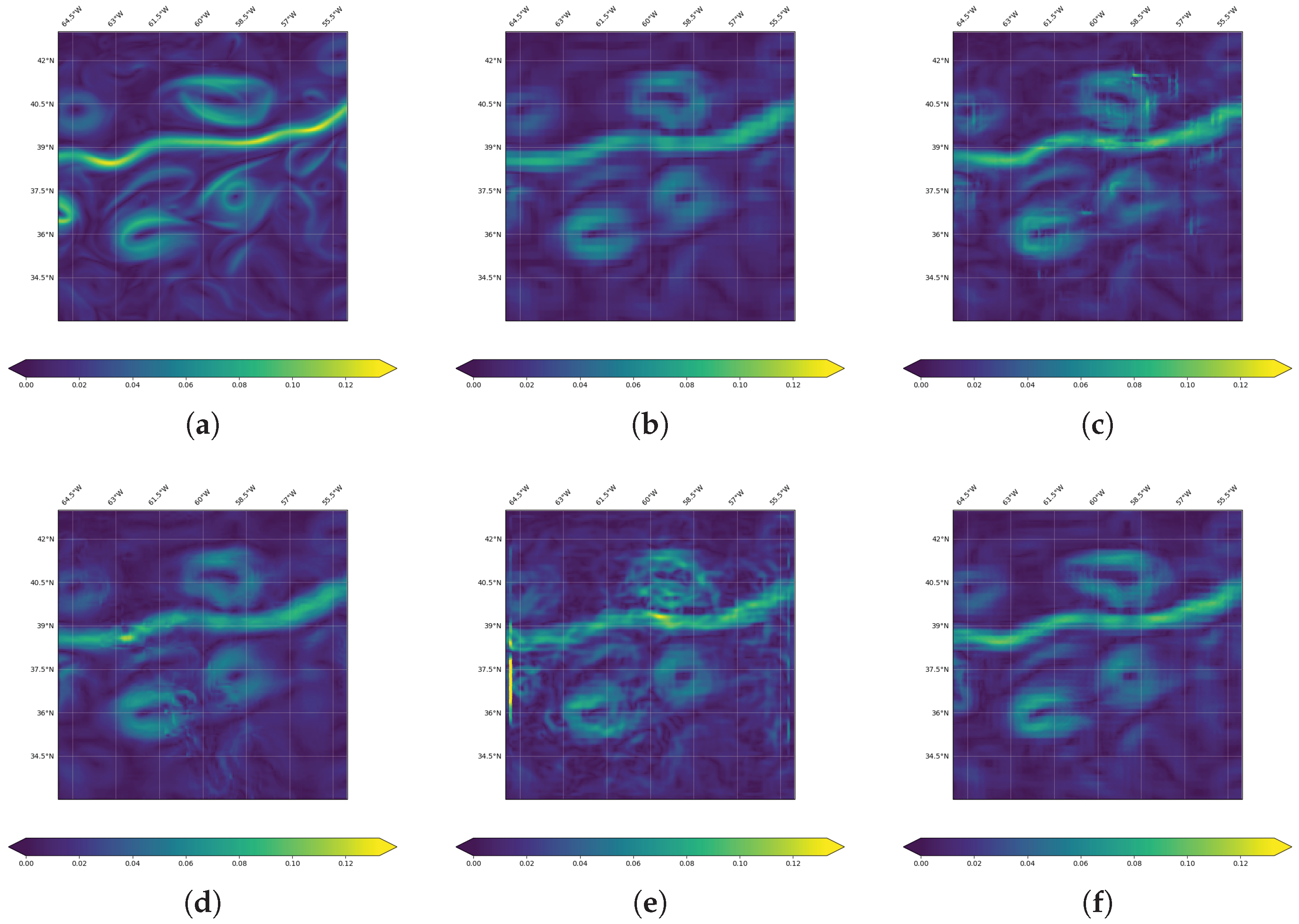
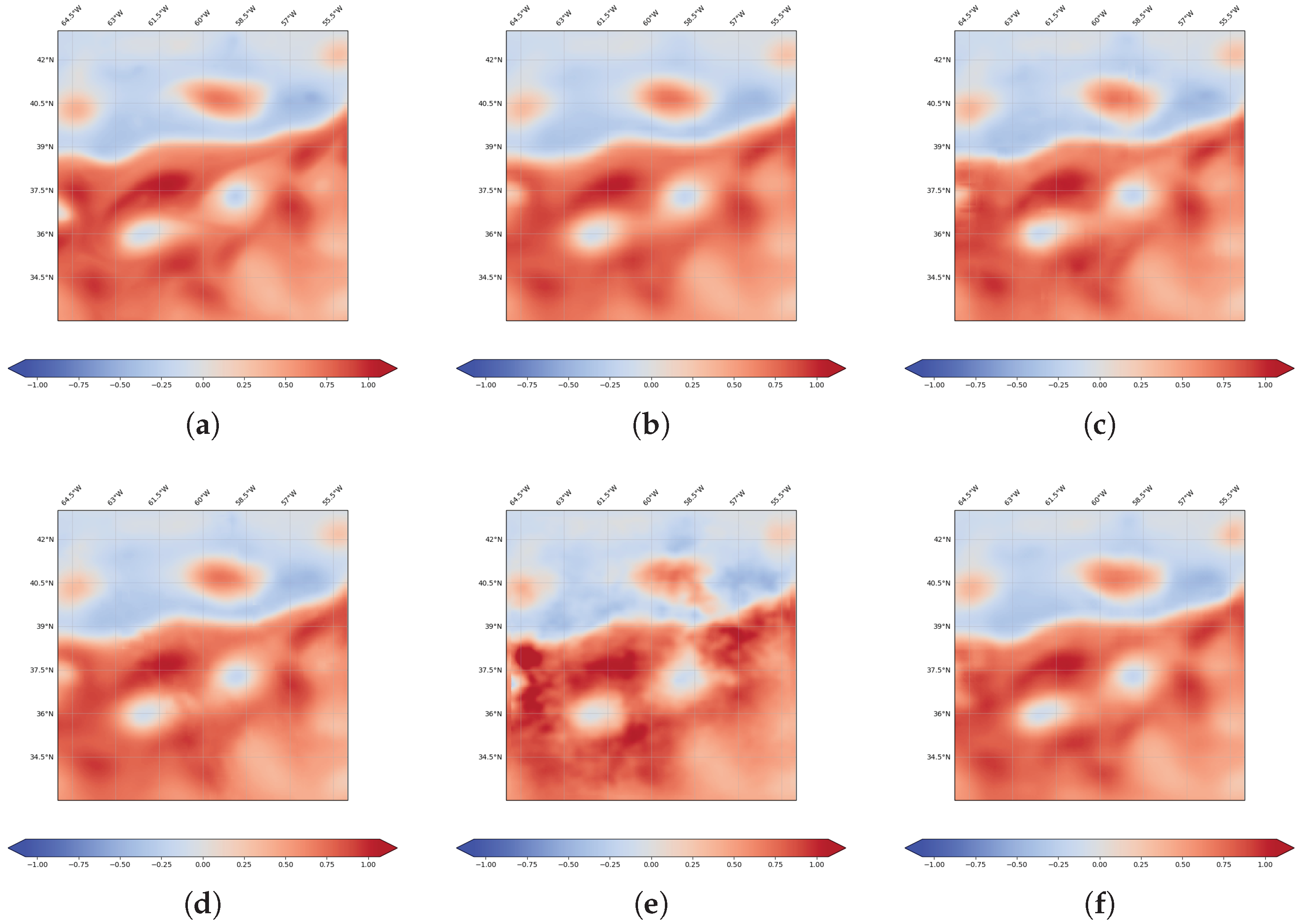

Appendix B.2. OSMOSIS

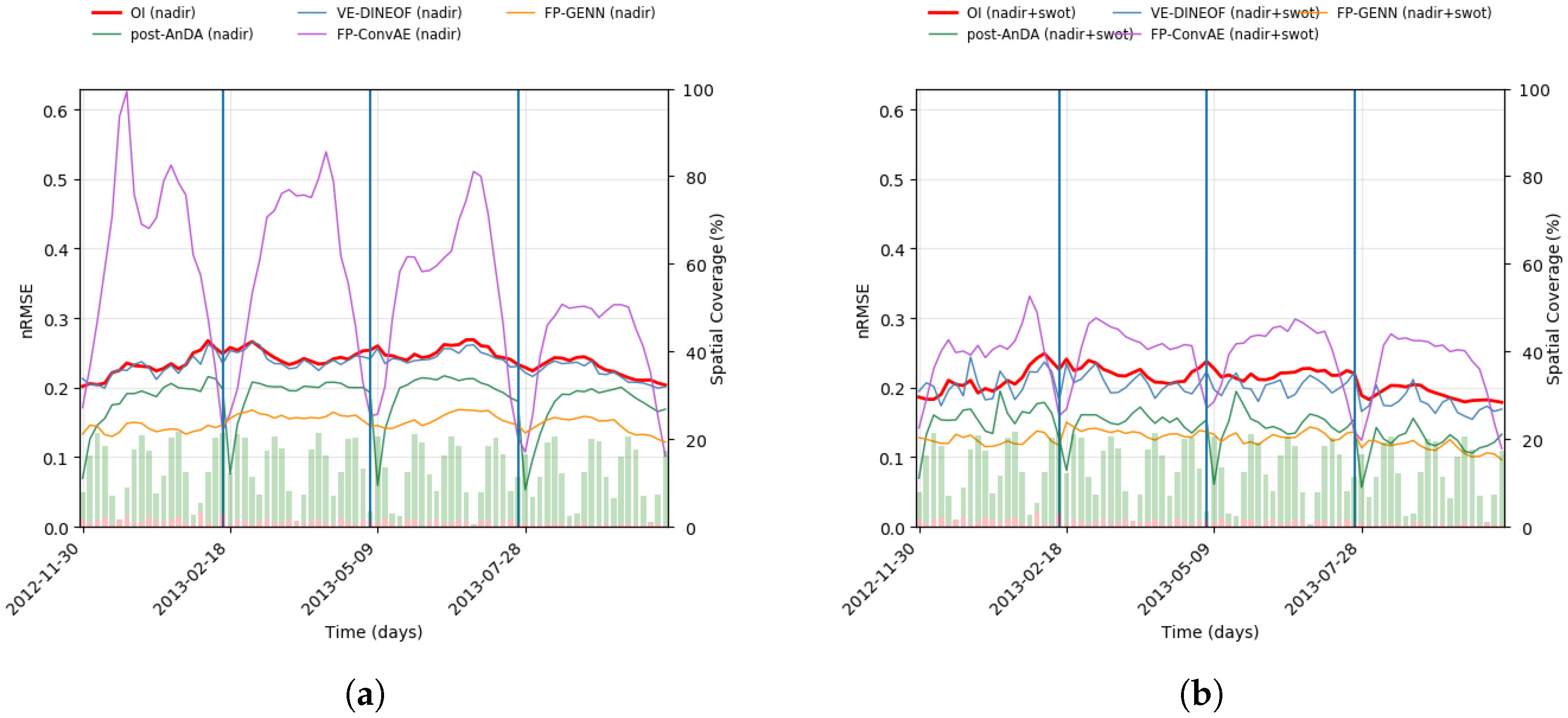
| Model Type | R-Score | I-Score | AE-Score | Model Type | R-Score | I-Score | AE-Score | ||
|---|---|---|---|---|---|---|---|---|---|
| nadir | OI | 44.63 | 34.93 | _ | nadir | 49.53 | 48.20 | _ | |
| AnDA | 76.60 | 59.42 | _ | 64.56 | 59.88 | _ | |||
| VE-DINEOF | 77.17 | 37.66 | _ | 58.71 | 45.61 | _ | |||
| FP-ConvAE | 28.39 | 17.00 | 42.94 | 22.47 | 19.12 | 36.66 | |||
| FP-GENN | 84.35 | 76.17 | 86.30 | 62.47 | 61.64 | 64.88 | |||
| nadir + SWOT | OI | 54.31 | 47.87 | _ | nadir + SWOT | 37.55 | 47.93 | _ | |
| AnDA | 83.07 | 74.95 | _ | 75.13 | 70.22 | _ | |||
| VE-DINEOF | 83.47 | 51.50 | _ | 79.31 | 49.32 | _ | |||
| FP-ConvAE | 36.80 | 33.37 | 47.56 | 30.85 | 35.06 | 39.06 | |||
| FP-GENN | 90.67 | 81.35 | 88.04 | 67.99 | 67.47 | 69.21 |
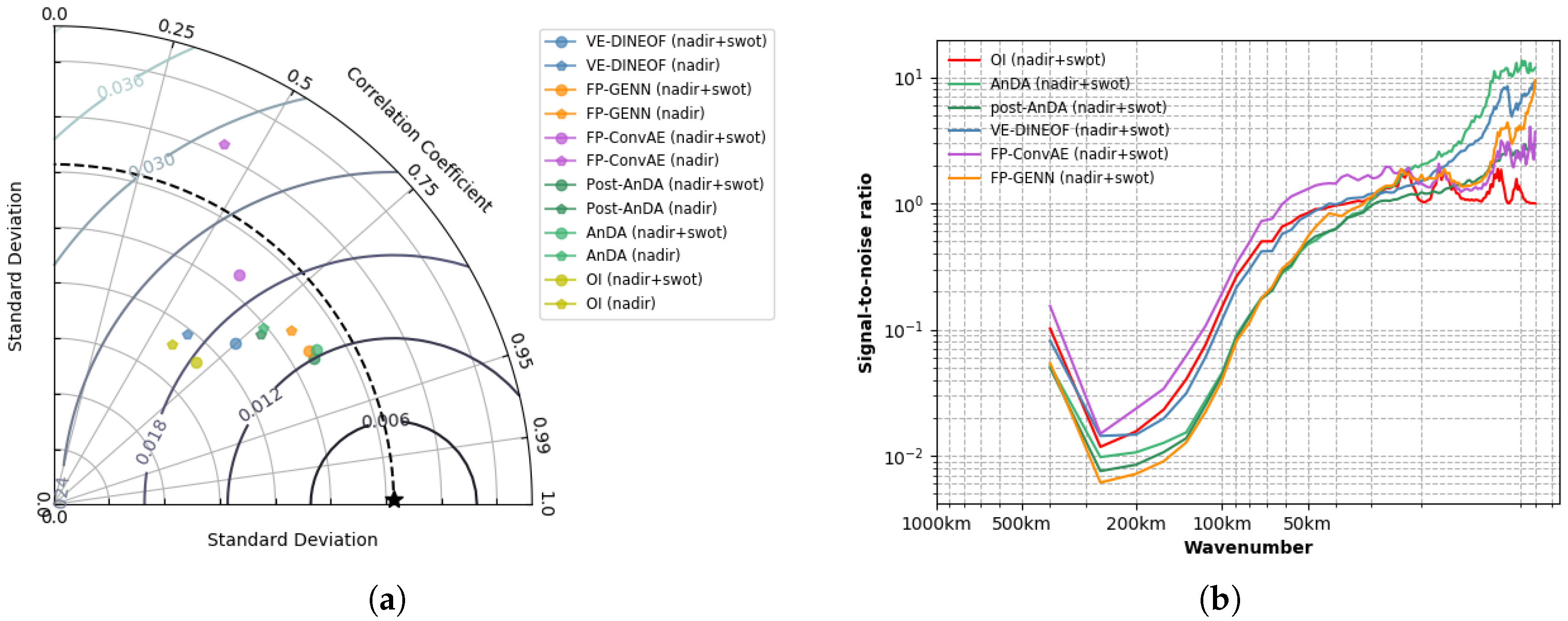
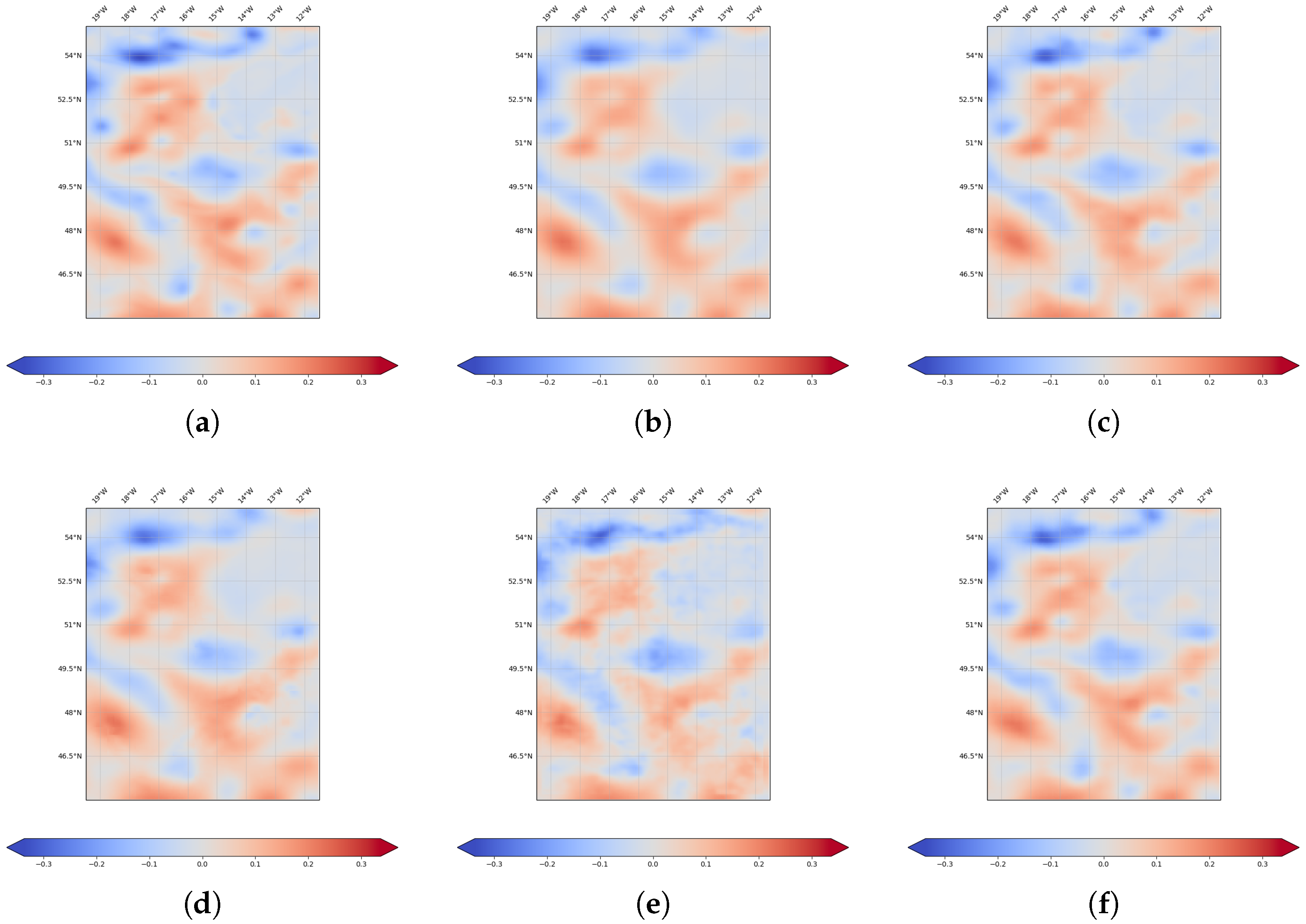
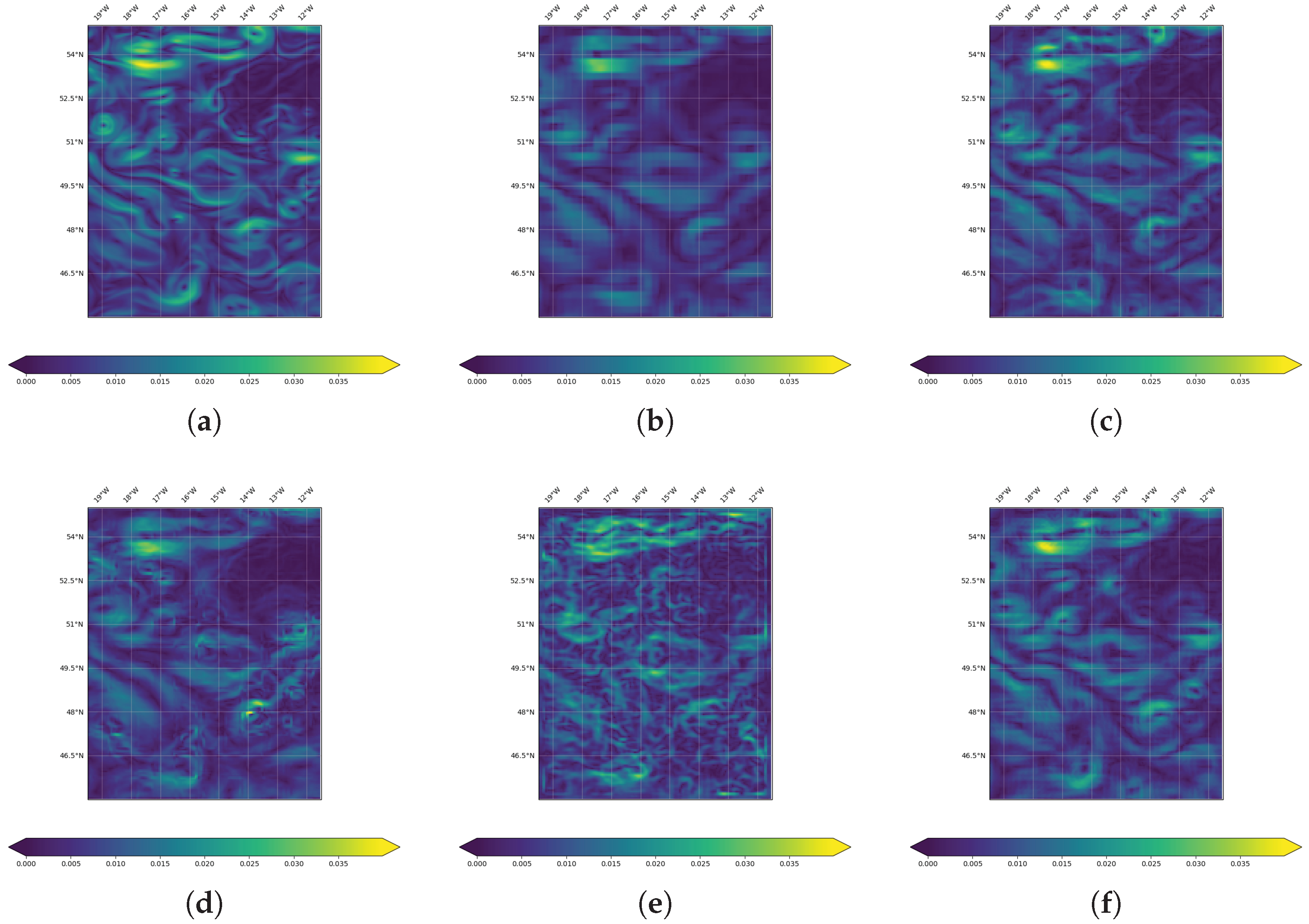
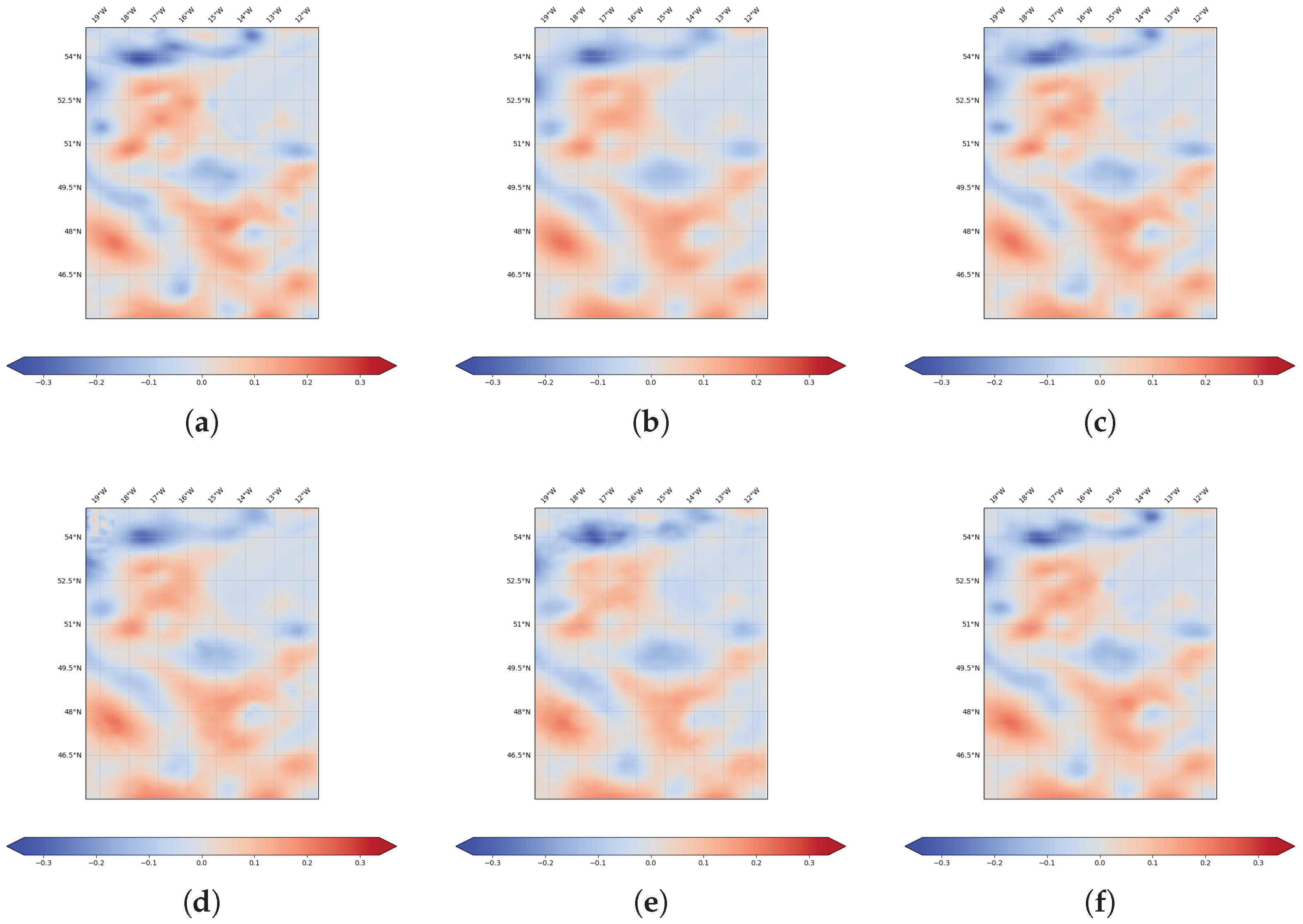
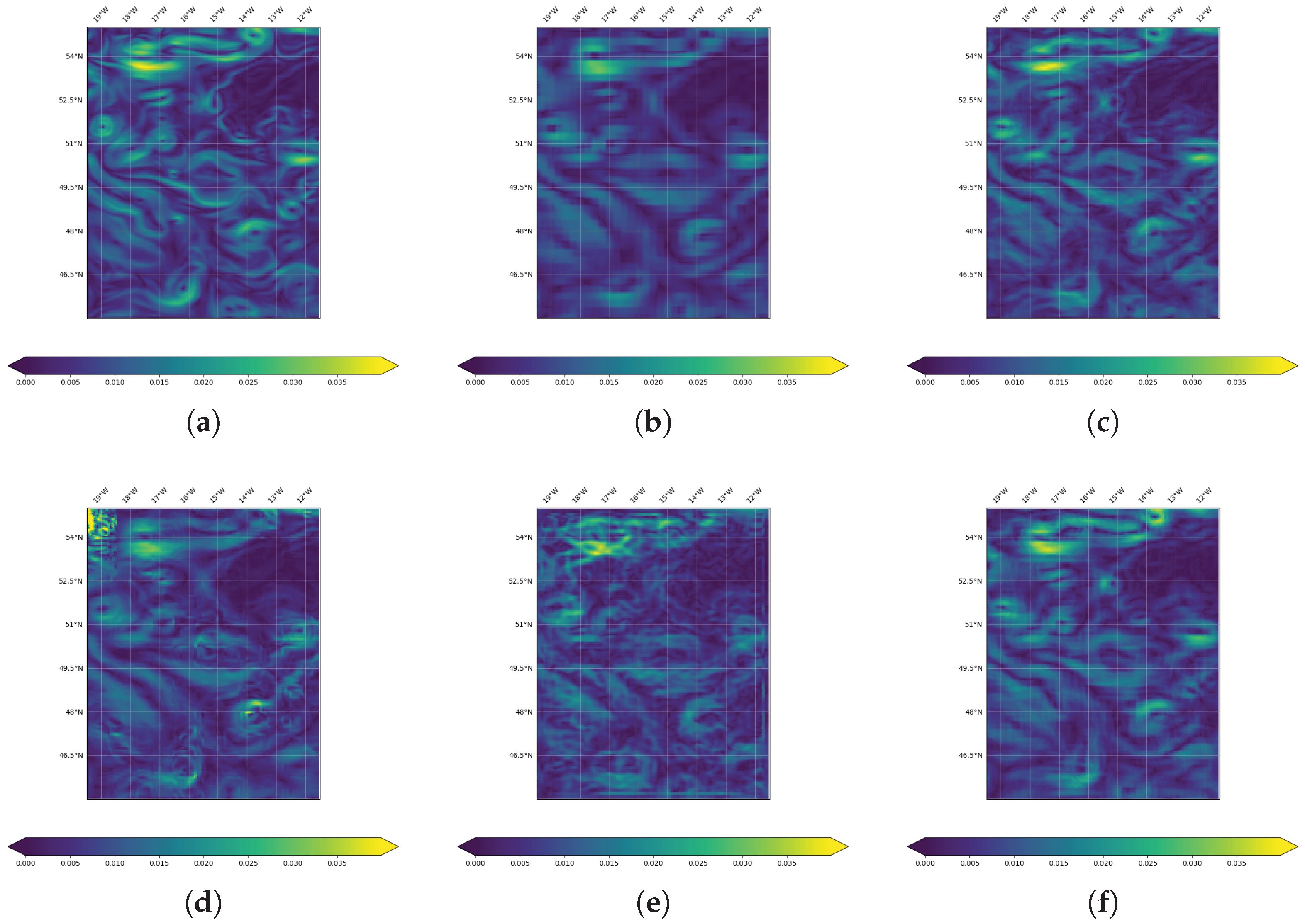
References
- Ballarotta, M.; Ubelmann, C.; Pujol, M.I.; Taburet, G.; Fournier, F.; Legeais, J.F.; Faugère, Y.; Delepoulle, A.; Chelton, D.; Dibarboure, G.; et al. On the resolutions of ocean altimetry maps. Ocean Sci. 2019, 15, 1091–1109. [Google Scholar] [CrossRef]
- Lguensat, R.; Tandeo, P.; Aillot, P.; Fablet, R. The Analog Data Assimilation. Mon. Weather Rev. 2017, 145, 4093–4107. [Google Scholar] [CrossRef]
- Lguensat, R.; Huynh Viet, P.; Sun, M.; Chen, G.; Fenglin, T.; Chapron, B.; Fablet, R. Data-driven Interpolation of Sea Level Anomalies using Analog Data Assimilation. Remote Sens. 2017, 11, 858. [Google Scholar] [CrossRef]
- Fablet, R.; Viet, P.H.; Lguensat, R. Data-Driven Models for the Spatio-Temporal Interpolation of Satellite-Derived SST Fields. IEEE Trans. Comput. Imaging 2017, 3, 647–657. [Google Scholar] [CrossRef]
- Lopez-Radcenco, M.; Pascual, A.; Gomez-Navarro, L.; Aissa-El-Bey, A.; Chapron, B.; Fablet, R. Analog Data Assimilation of Along-Track Nadir and Wide-Swath SWOT Altimetry Observations in the Western Mediterranean Sea. IEEE J. Sel. Top. Appl. Earth Obs. Remote Sens. 2019, 1–11. [Google Scholar] [CrossRef]
- Ouala, S.; Fablet, R.; Herzet, C.; Chapron, B.; Pascual, A.; Collard, F.; Gaultier, L. Neural Network Based Kalman Filters for the Spatio-Temporal Interpolation of Satellite-Derived Sea Surface Temperature. Remote Sens. 2018, 10, 1864. [Google Scholar] [CrossRef]
- Taburet, G.; Sanchez-Roman, A.; Ballarotta, M.; Pujol, M.I.; Legeais, J.F.; Fournier, F.; Faugere, Y.; Dibarboure, G. DUACS DT2018: 25 years of reprocessed sea level altimetry products. Ocean Sci. 2019, 15, 1207–1224. [Google Scholar] [CrossRef]
- Molines, J.M. Meom-Configurations/NATL60-CJM165: NATL60 Code Used for CJM165 Experiment; Zenodo: Geneva, Switzerland, 2018. [Google Scholar] [CrossRef]
- Dufau, C.; Orsztynowicz, M.; Dibarboure, G.; Morrow, R.; Le Traon, P.Y. Mesoscale resolution capability of altimetry: Present and future. J. Geophys. Res. Ocean. 2016, 121, 4910–4927. [Google Scholar] [CrossRef]
- Gaultier, L.; Ubelmann, C.; Fu, L.L. The Challenge of Using Future SWOT Data for Oceanic Field Reconstruction. J. Atmos. Ocean. Technol. 2015, 33, 119–126. [Google Scholar] [CrossRef]
- Esteban-Fernandez, D. SWOT Project Mission Performance and Error Budget Document; Technical Report; JPL, NASA: Pasadena, CA, USA, 2014. [Google Scholar]
- Gaultier, L.; Ubelmann, C. SWOT Simulator Documentation; Technical Report; JPL, NASA: Pasadena, CA, USA, 2010. [Google Scholar]
- Metref, S.; Cosme, E.; Le Guillou, F.; Le Sommer, J.; Brankart, J.M.; Verron, J. Wide-Swath Altimetric Satellite Data Assimilation With Correlated-Error Reduction. Front. Mar. Sci. 2020, 6, 822. [Google Scholar] [CrossRef]
- Ping, B.; Su, F.; Meng, Y. An Improved DINEOF Algorithm for Filling Missing Values in Spatio-Temporal Sea Surface Temperature Data. PLoS ONE 2016, 11, e0155928. [Google Scholar] [CrossRef] [PubMed]
- Fablet, R.; Drumetz, L.; Rousseau, F.; Beauchamp, M. Joint Interpolation and Representation Learning for Irregularly-Sampled Satellite-Derived Geophysical Fields; IMT Atlantique: Brest, France, 2020. [Google Scholar]
- Fablet, R.; Drumetz, L.; Rousseau, F. Joint learning of variational representations and solvers for inverse problems with partially-observed data. arXiv 2020, arXiv:2006.03653. [Google Scholar]
- Welch, P. The use of fast Fourier transform for the estimation of power spectra: A method based on time averaging over short, modified periodograms. IEEE Trans. Audio Electroacoust. 1967, 15, 70–73. [Google Scholar] [CrossRef]
- Lindgren, F.; Rue, H.; Lindström, J. An explicit link between Gaussian fields and Gaussian Markov random fields: The stochastic partial differential equation approach. J. R. Stat. Soc. Ser. B (Stat. Methodol.) 2011, 73, 423–498. [Google Scholar] [CrossRef]
- Sidén, P.; Lindsten, F. Deep Gaussian Markov random fields. arXiv 2020, arXiv:2002.07467. [Google Scholar]
- Ardhuin, F.; Brandt, P.; Gaultier, L.; Donlon, C.; Battaglia, A.; Boy, F.; Casal, T.; Chapron, B.; Collard, F.; Cravatte, S.; et al. SKIM, a Candidate Satellite Mission Exploring Global Ocean Currents and Waves. Front. Mar. Sci. 2019. [Google Scholar] [CrossRef]
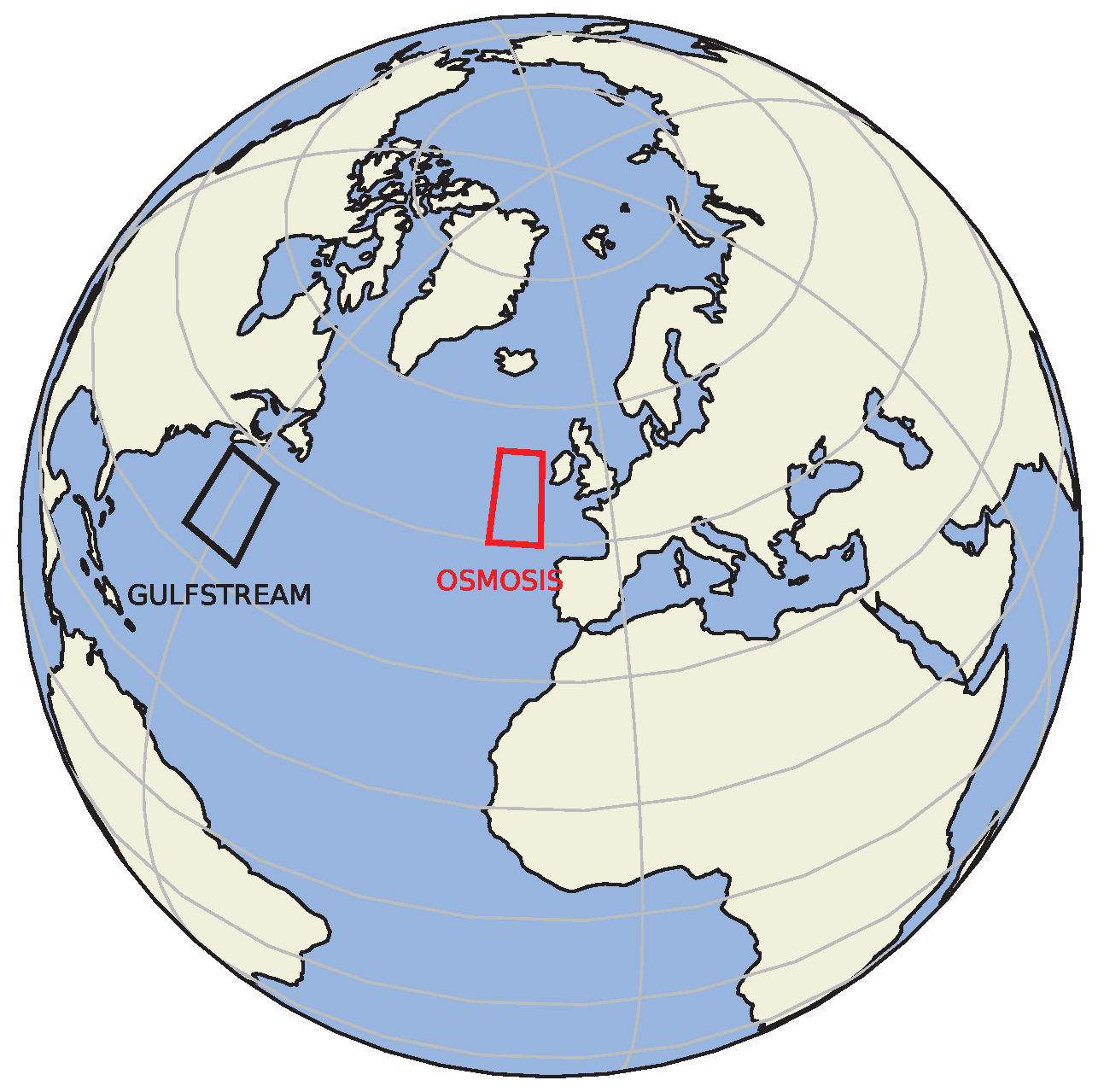
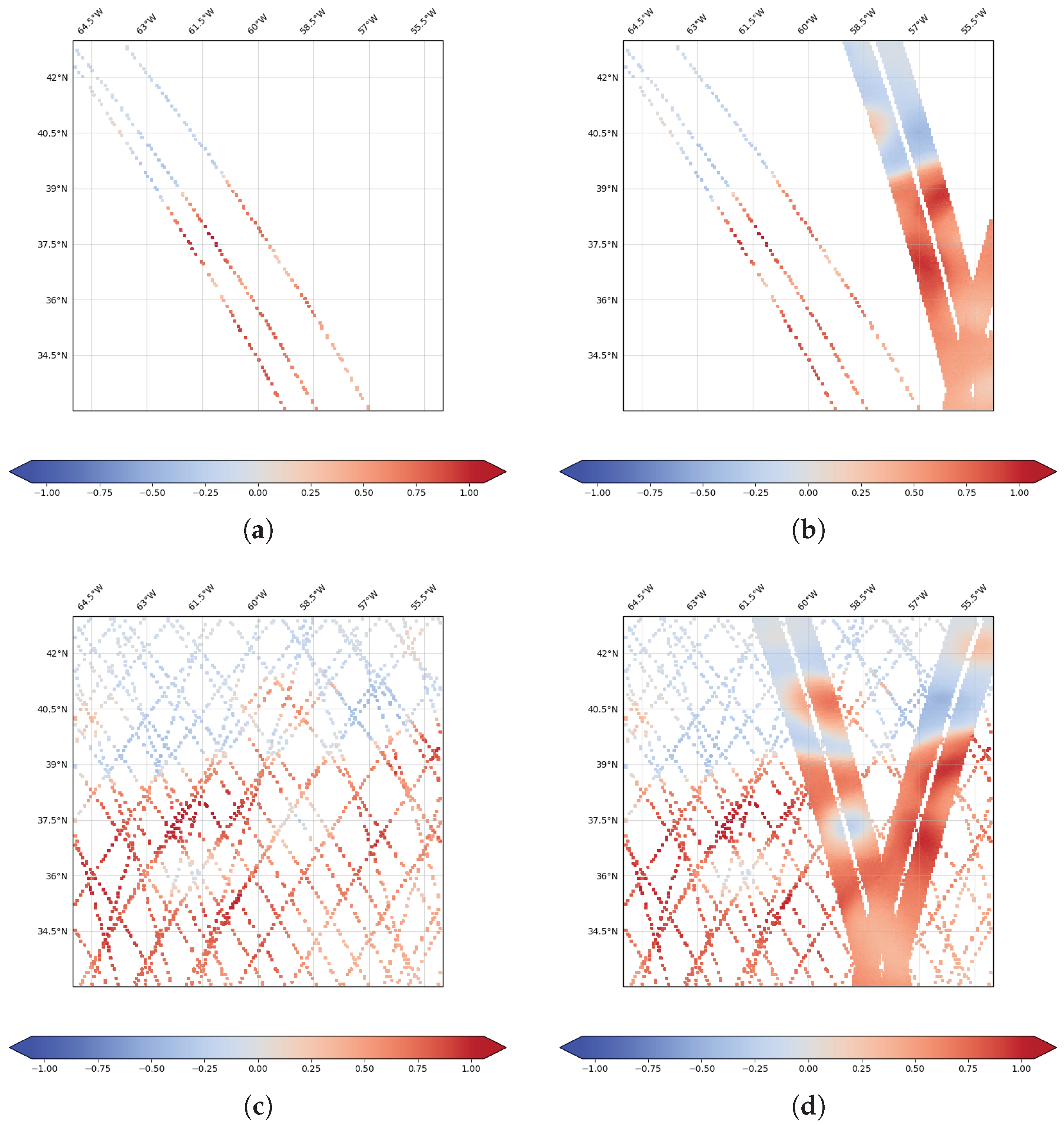
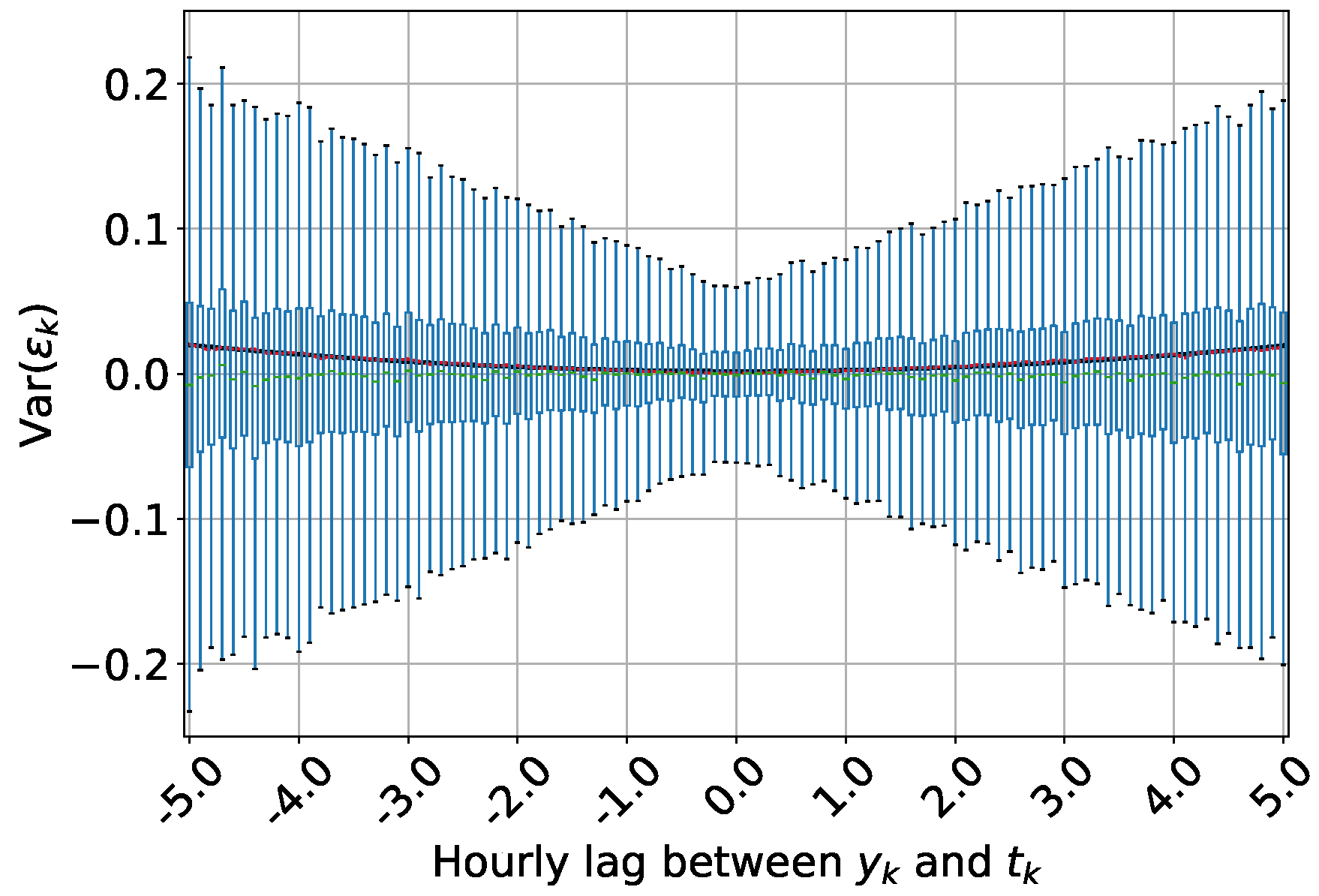
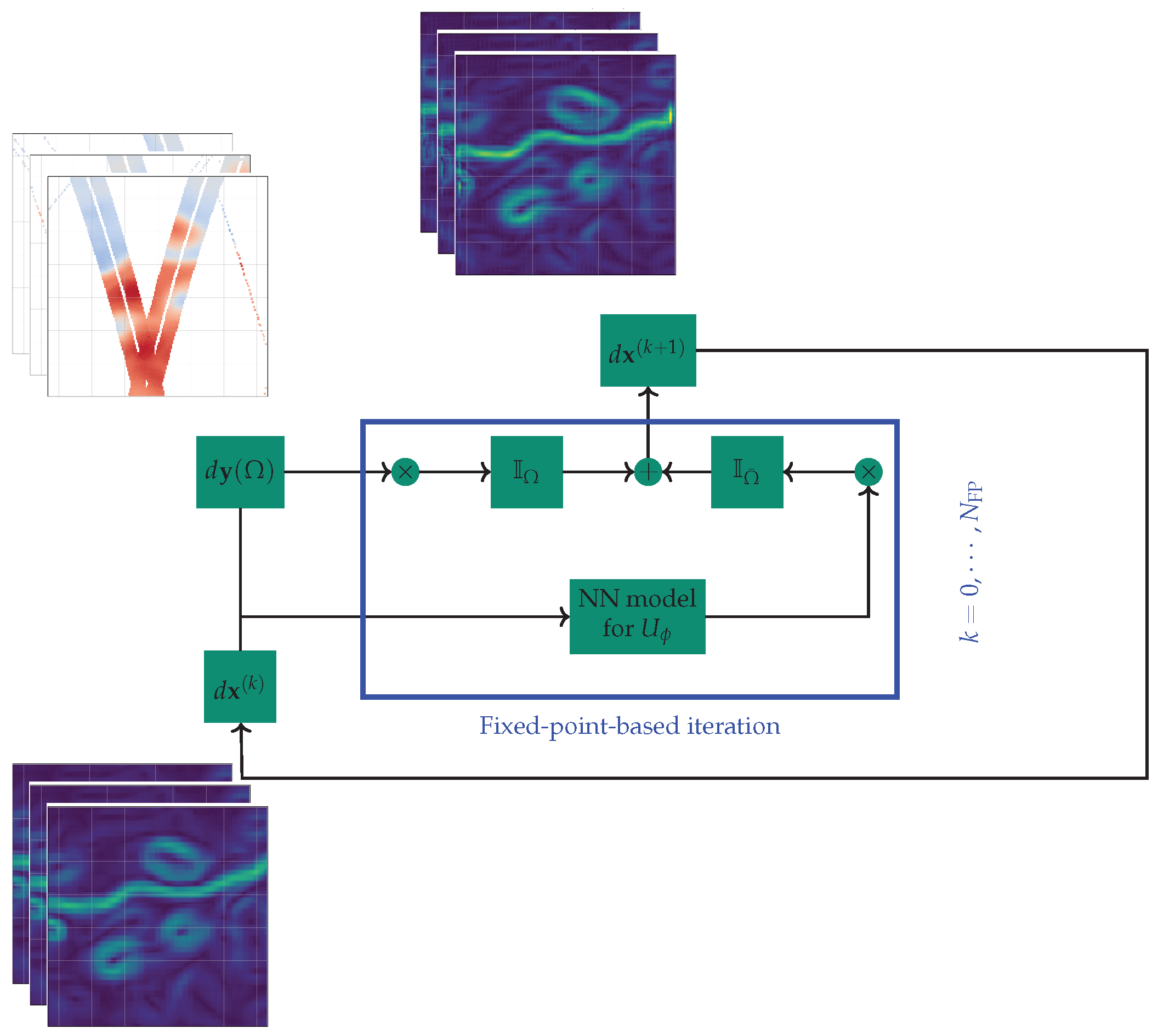
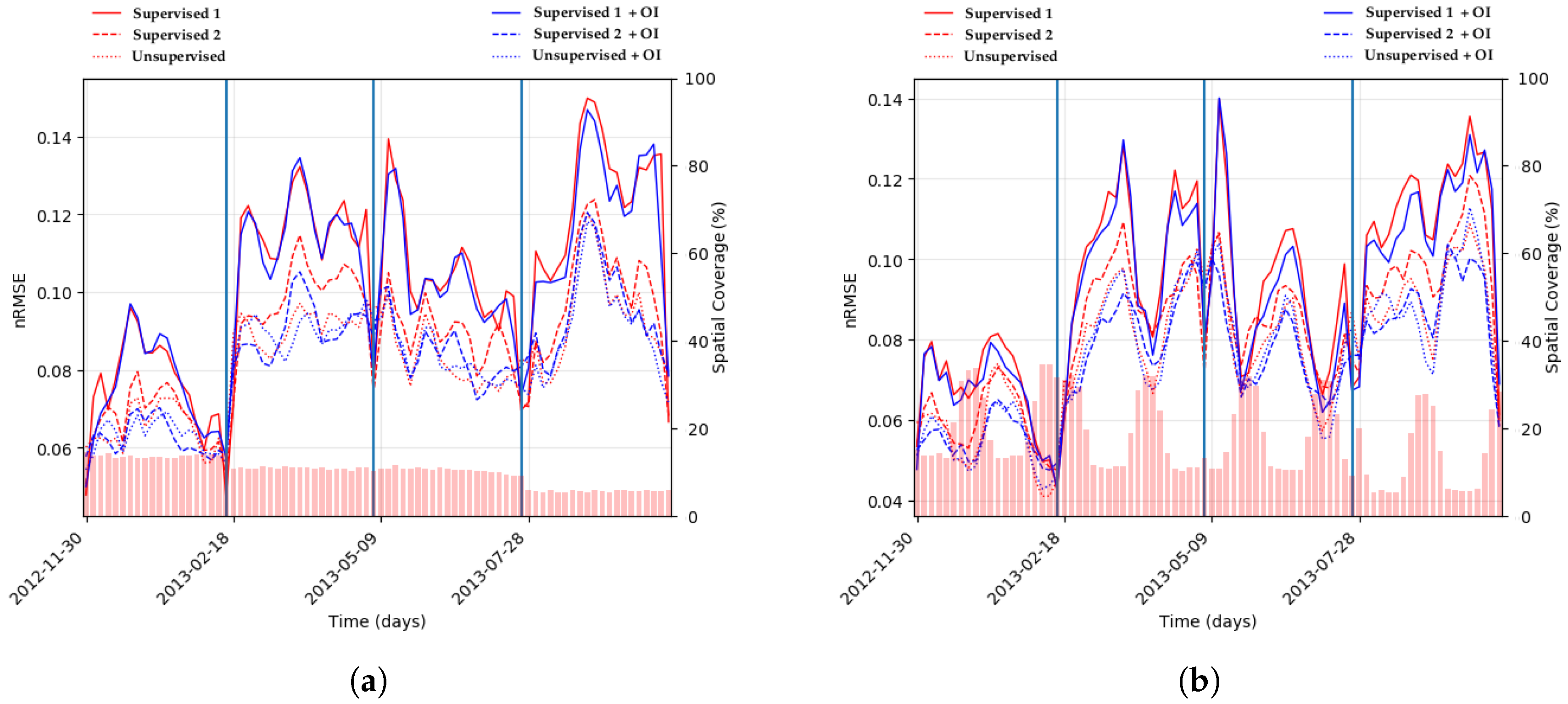
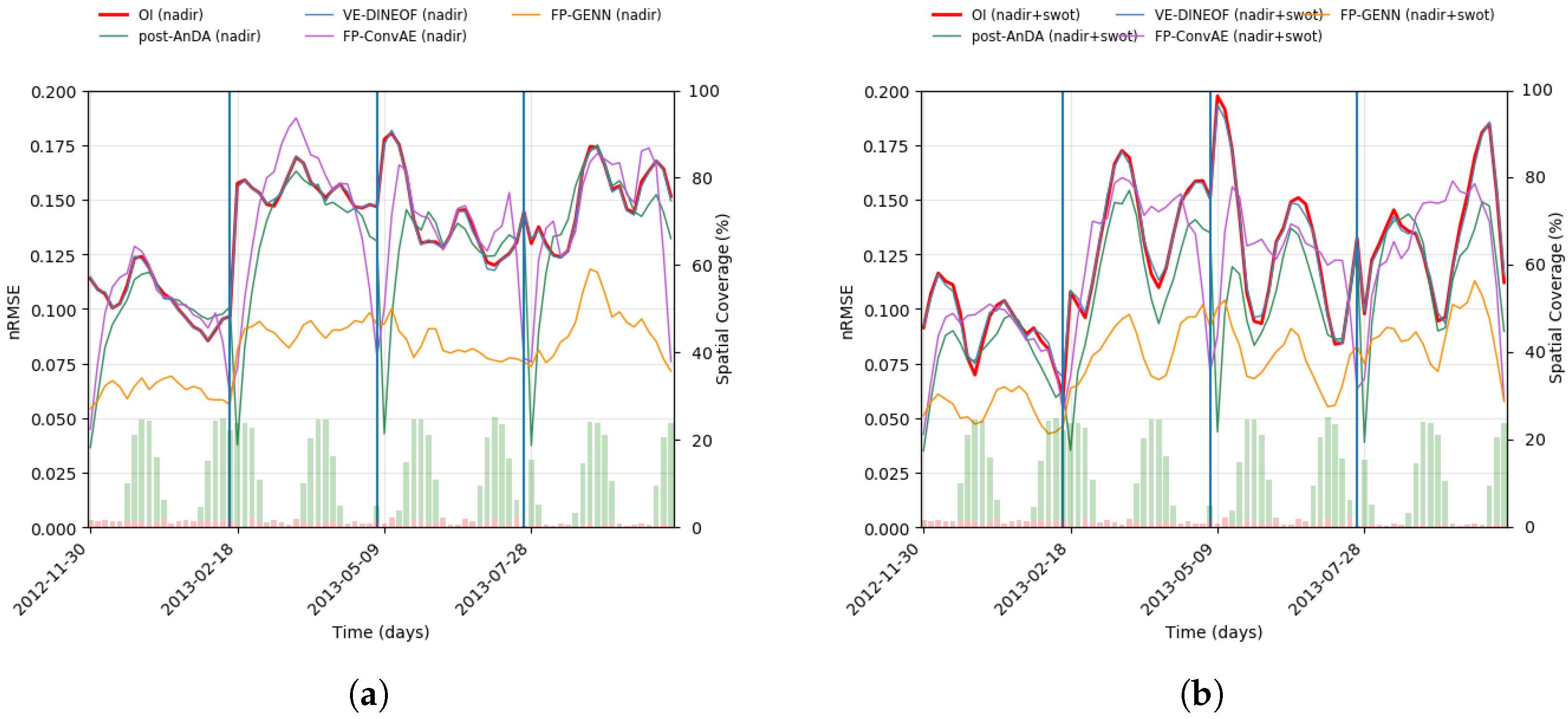

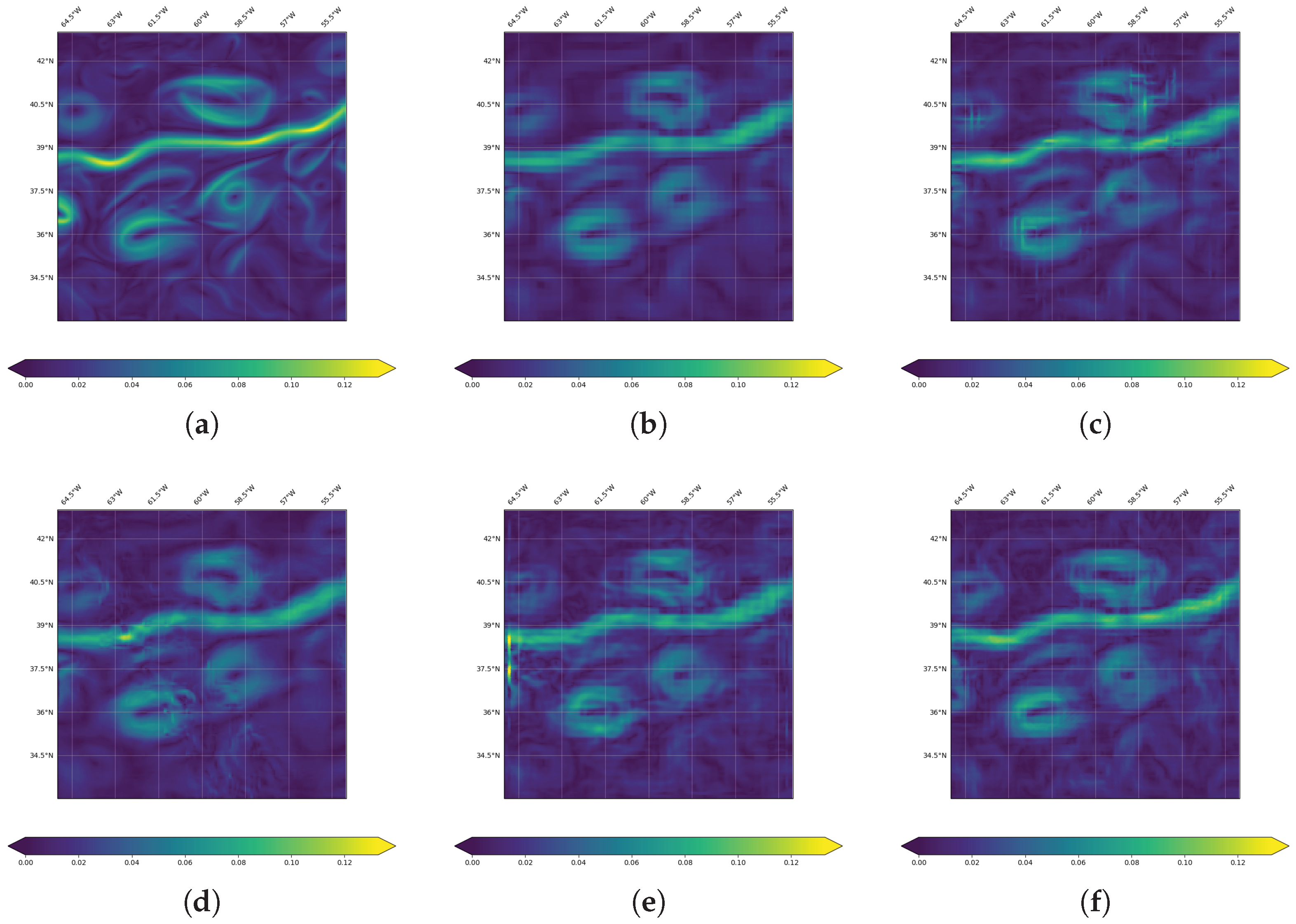


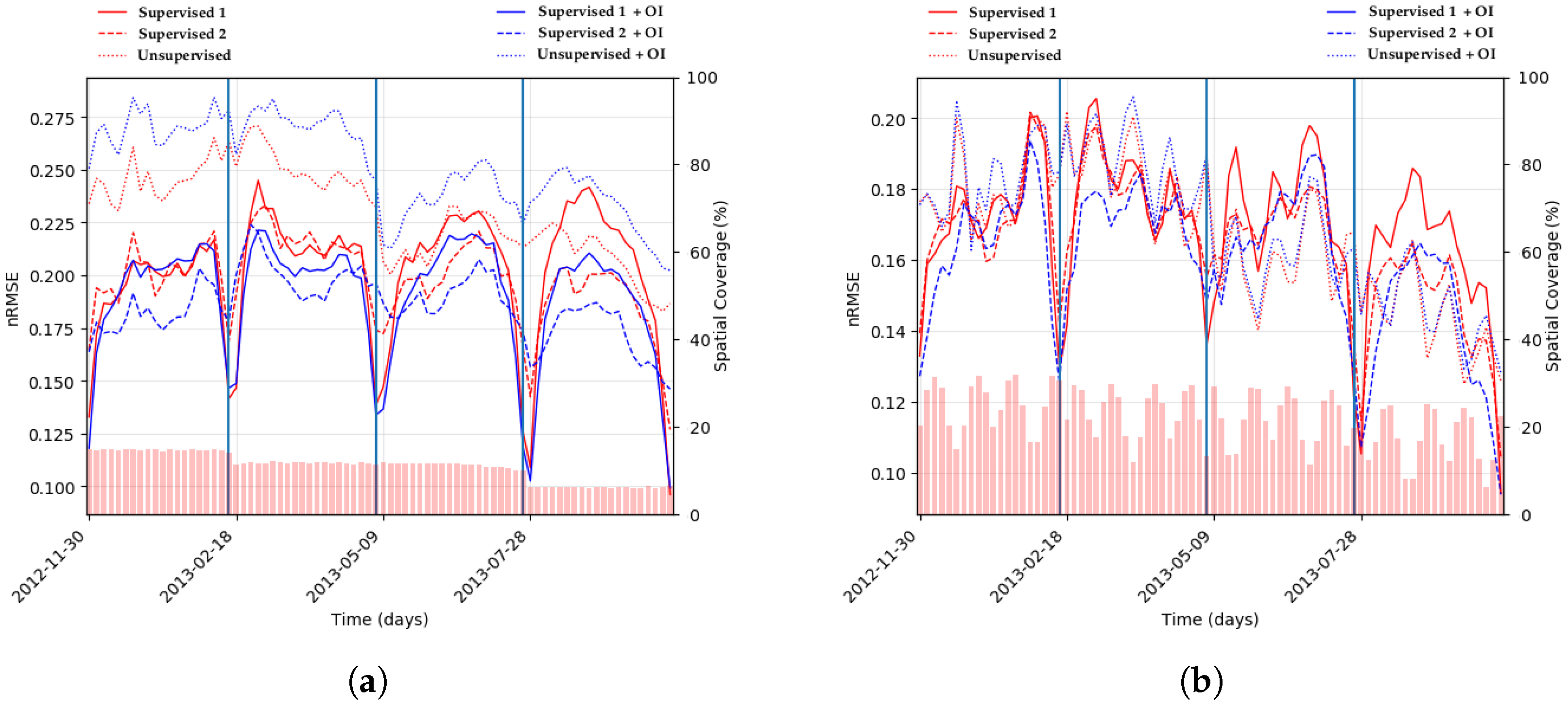
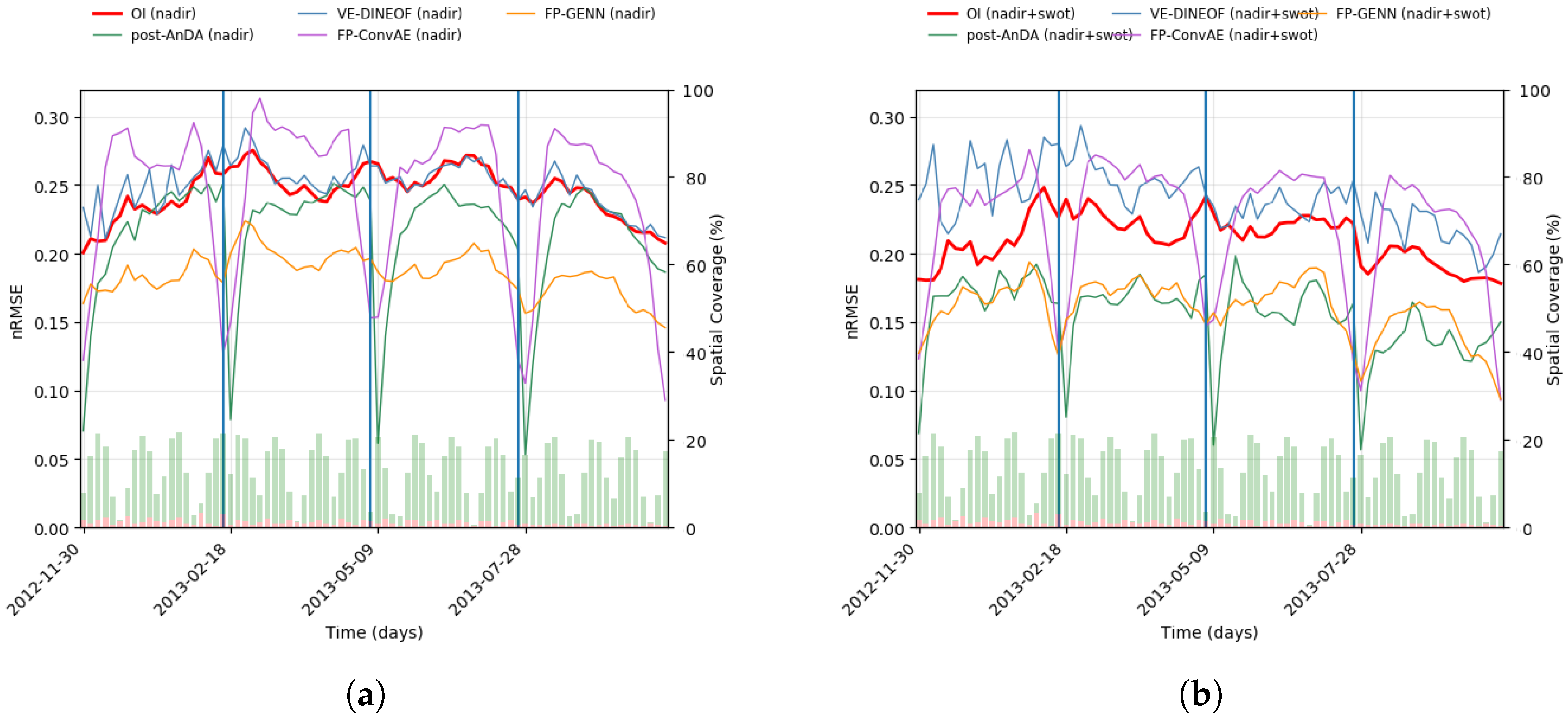
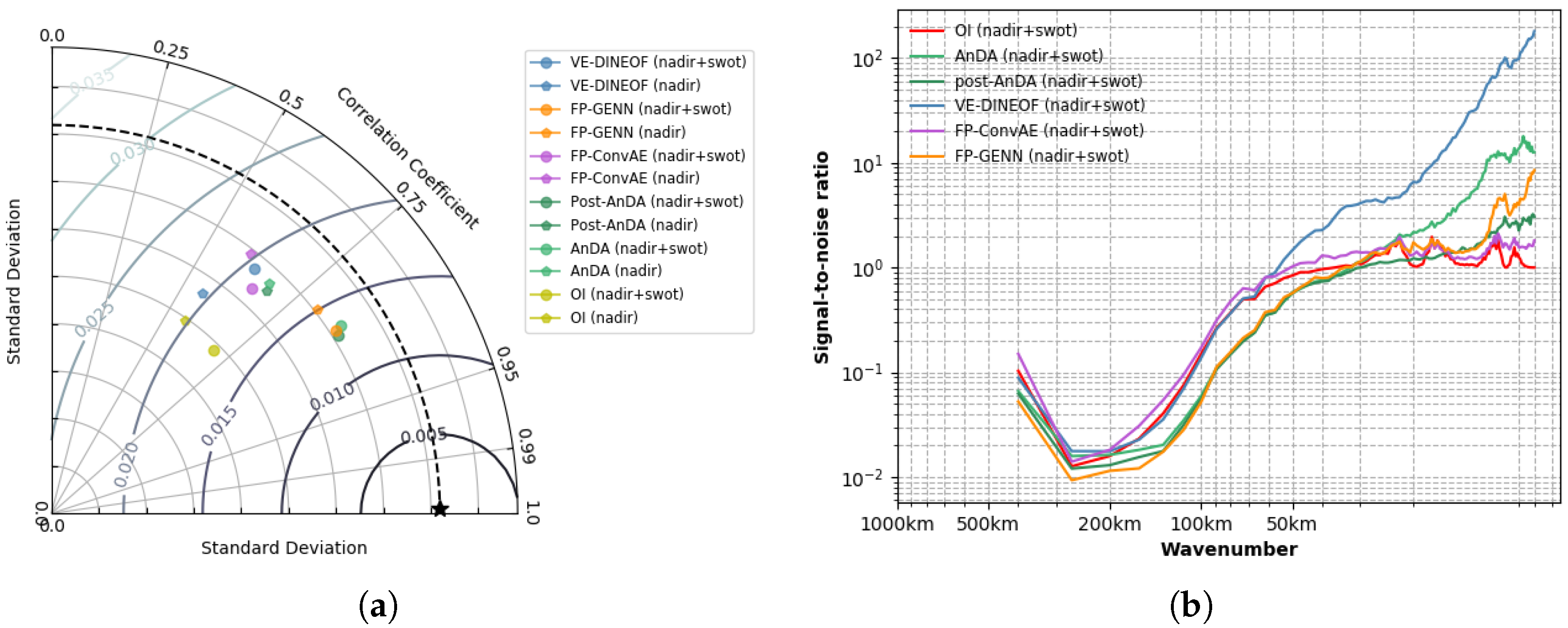
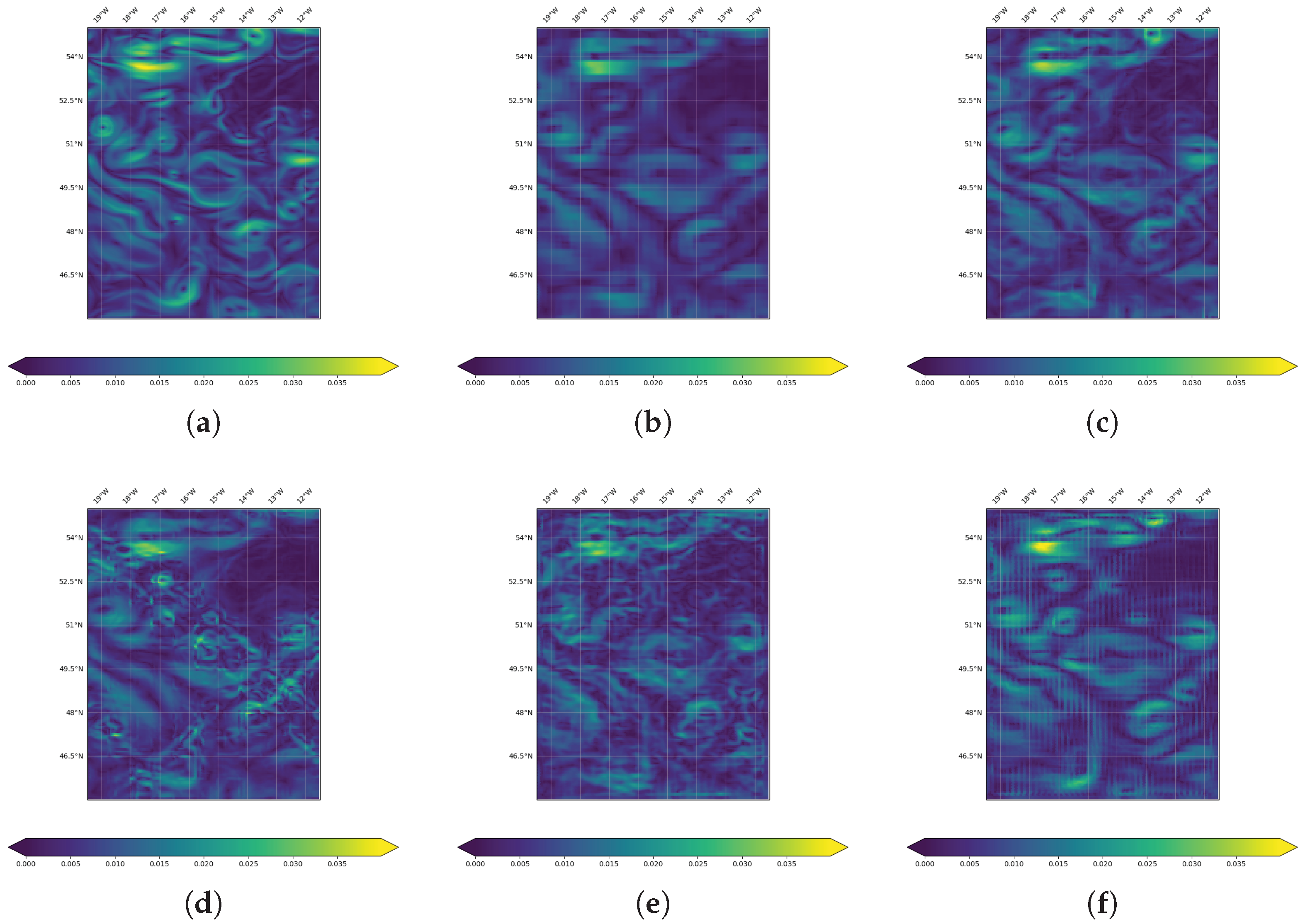
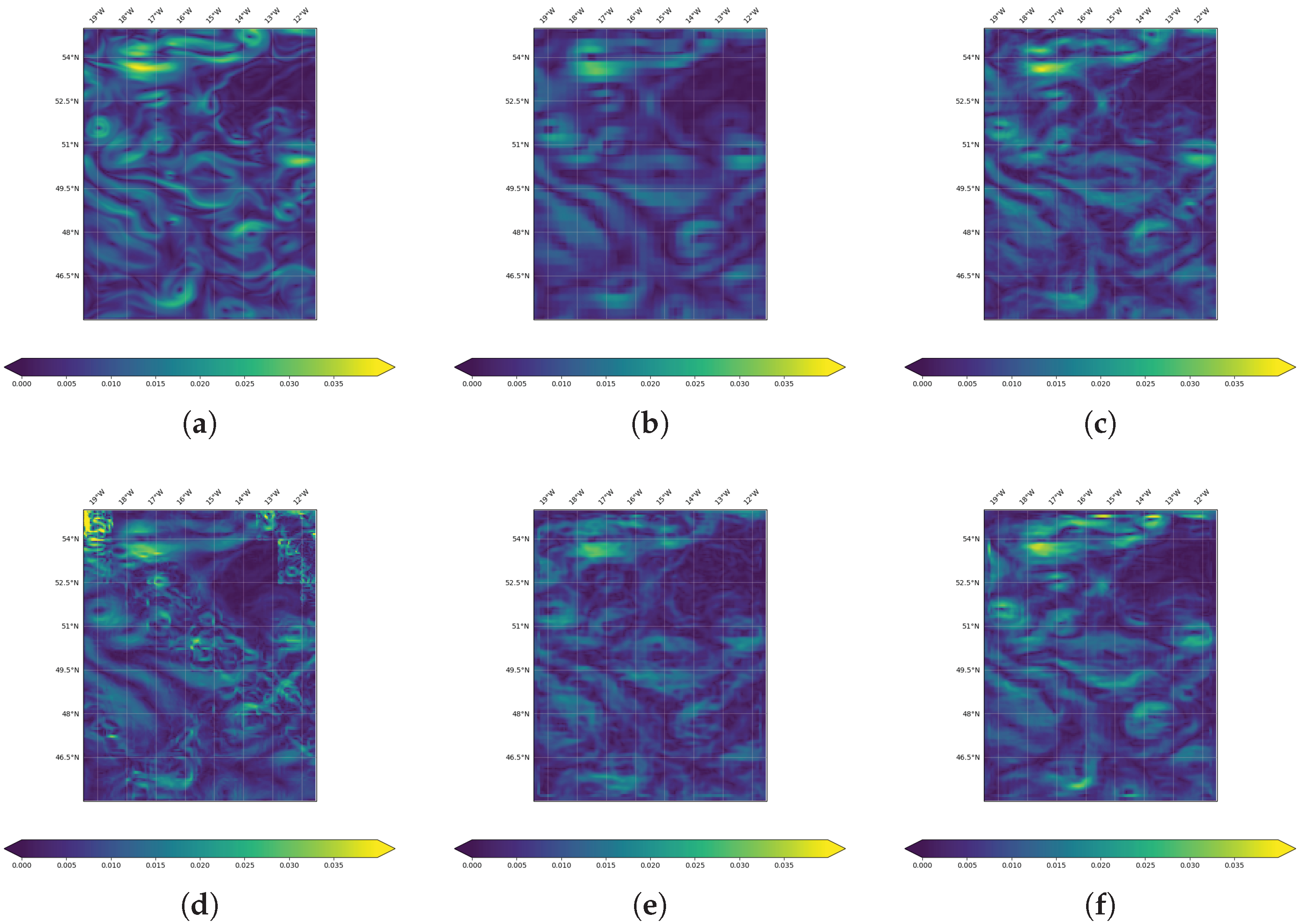
| Name | Formula | |
|---|---|---|
| nRMSE | nRMSE() = | |
| Error variance | = | |
| Correlation | COR() = | |
| Temporal domain | Reconstruction score | R-score = |
| Interpolation score | I-score = | |
| Auto-encoder score | AE-score = | |
| Spectral domain | RAPS | RAPS() = |
| Signal-to-Noise Ratio | SNR() = |
| Configurations | Data | |||
|---|---|---|---|---|
| Observations | Gap-Free Maps | DUACS OI | ||
| Supervised 1 | Input | 🗸 | yes/no | |
| Target | 🗸 | |||
| Supervised 2 | Input | 🗸 | yes/no | |
| Target | 🗸 | |||
| Unsupervised | Input | 🗸 | yes/no | |
| Target | 🗸 | |||
| Model Type | R-Score | I-Score | AE-Score | Model Type | R-Score | I-Score | AE-Score | ||
|---|---|---|---|---|---|---|---|---|---|
| nadir | OI | 87.32 | 72.17 | _ | nadir | 78.03 | 75.97 | _ | |
| AnDA | 94.85 | 77.91 | _ | 85.56 | 79.14 | _ | |||
| VE-DINEOF | 96.11 | 72.72 | _ | 82.69 | 75.61 | _ | |||
| FP-ConvAE | 87.82 | 76.32 | 82.85 | 77.80 | 76.81 | 75.89 | |||
| FP-GENN | 91.78 | 84.56 | 93.15 | 81.05 | 80.56 | 84.24 | |||
| nadir + SWOT | OI | 93.25 | 74.25 | _ | nadir + SWOT | 73.83 | 75.78 | ||
| AnDA | 96.05 | 83.55 | _ | 89.89 | 82.88 | _ | |||
| VE-DINEOF | 97.13 | 75.28 | _ | 88.19 | 76.69 | _ | |||
| FP-ConvAE | 80.63 | 77.51 | 83.26 | 76.20 | 76.49 | 75.84 | |||
| FP-GENN | 96.49 | 90.13 | 95.58 | 86.96 | 85.33 | 88.23 |
| Model Type | R-Score | I-Score | AE-Score | Model Type | R-Score | I-Score | AE-Score | ||
|---|---|---|---|---|---|---|---|---|---|
| nadir | OI | 42.05 | 32.11 | _ | nadir | 48.83 | 47.57 | _ | |
| AnDA | 58.85 | 47.02 | _ | 58.78 | 55.17 | _ | |||
| VE-DINEOF | 26.29 | 30.61 | _ | 33.11 | 35.28 | _ | |||
| FP-ConvAE | 37.20 | 31.67 | 47.77 | 32.15 | 35.87 | 41.24 | |||
| FP-GENN | 67.94 | 62.52 | 80.40 | 50.53 | 52.12 | 60.41 | |||
| nadir + SWOT | OI | 54.21 | 47.75 | _ | nadir + SWOT | 36.83 | 47.30 | _ | |
| AnDA | 81.15 | 70.91 | _ | 72.35 | 67.59 | _ | |||
| VE-DINEOF | 69.08 | 32.98 | _ | 22.08 | 24.90 | _ | |||
| FP-ConvAE | 45.15 | 42.70 | 47.93 | 38.22 | 43.13 | 42.03 | |||
| FP-GENN | 77.16 | 69.56 | 83.08 | 56.29 | 59.21 | 67.69 |
Publisher’s Note: MDPI stays neutral with regard to jurisdictional claims in published maps and institutional affiliations. |
© 2020 by the authors. Licensee MDPI, Basel, Switzerland. This article is an open access article distributed under the terms and conditions of the Creative Commons Attribution (CC BY) license (http://creativecommons.org/licenses/by/4.0/).
Share and Cite
Beauchamp, M.; Fablet, R.; Ubelmann, C.; Ballarotta, M.; Chapron, B. Intercomparison of Data-Driven and Learning-Based Interpolations of Along-Track Nadir and Wide-Swath SWOT Altimetry Observations. Remote Sens. 2020, 12, 3806. https://doi.org/10.3390/rs12223806
Beauchamp M, Fablet R, Ubelmann C, Ballarotta M, Chapron B. Intercomparison of Data-Driven and Learning-Based Interpolations of Along-Track Nadir and Wide-Swath SWOT Altimetry Observations. Remote Sensing. 2020; 12(22):3806. https://doi.org/10.3390/rs12223806
Chicago/Turabian StyleBeauchamp, Maxime, Ronan Fablet, Clément Ubelmann, Maxime Ballarotta, and Bertrand Chapron. 2020. "Intercomparison of Data-Driven and Learning-Based Interpolations of Along-Track Nadir and Wide-Swath SWOT Altimetry Observations" Remote Sensing 12, no. 22: 3806. https://doi.org/10.3390/rs12223806
APA StyleBeauchamp, M., Fablet, R., Ubelmann, C., Ballarotta, M., & Chapron, B. (2020). Intercomparison of Data-Driven and Learning-Based Interpolations of Along-Track Nadir and Wide-Swath SWOT Altimetry Observations. Remote Sensing, 12(22), 3806. https://doi.org/10.3390/rs12223806







